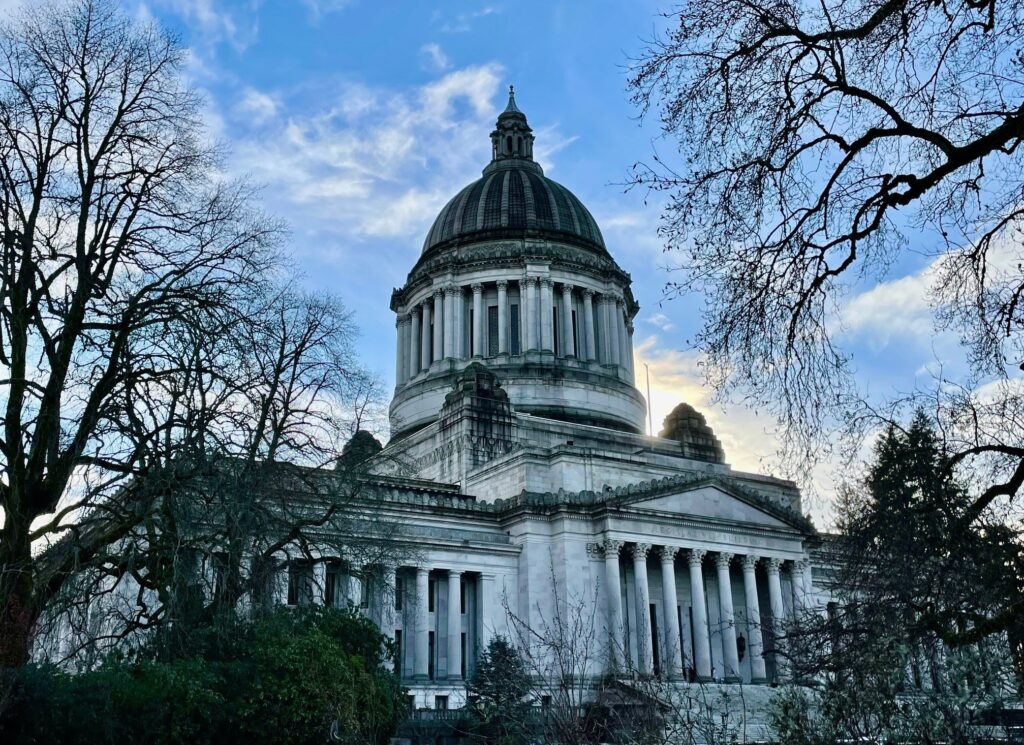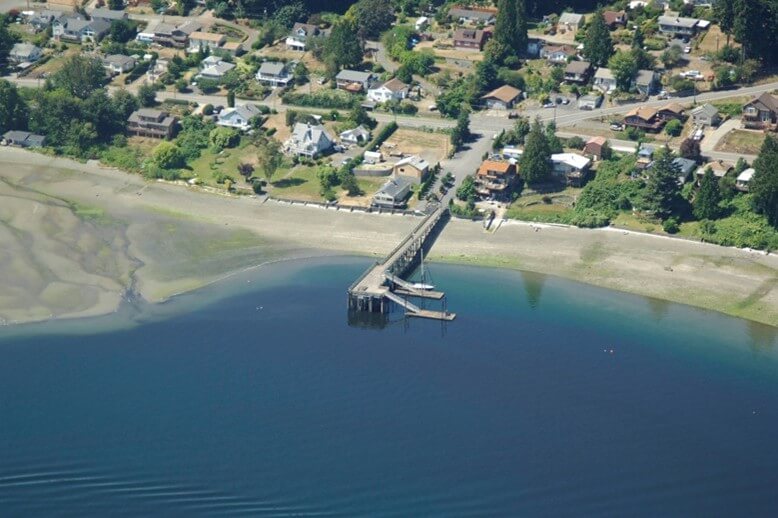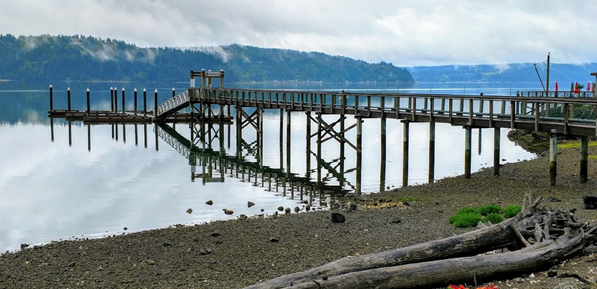With just a few short weeks left of the 2024 legislative session, this past week saw all budget proposals released for review and public hearings. In even-numbered years, Washington has a short, sixty-day legislative session. This is where lawmakers consider and adopt supplemental budgets, minor adjustments to the biennial budgets passed in odd-numbered years during long sessions. Most of the adjustments are based on updated state caseloads and revenue changes. We do not expect significant new programs and spending in supplemental budgets.

Carly Michiels, Eric ffitch, Chris Herman in the Washington State Capitol.
Washington has three budgets: Operating, Capital, and Transportation. The Governor first introduced his (3) budget proposals in December, and our legislative team put together a preview of that proposal here. At that time, the Governor indicated his top priorities for the supplemental budgets were behavioral health, addressing the fentanyl/opioid crisis, housing and homelessness, cap and trade investments, and education. These priorities were consistent with the Legislature.
After the Governor’s budget proposals were introduced, the State House and Senate got to work on drafting their individual budgets. In addition to supplemental budgets, the legislature still managed to introduce over 1400 new bills this session for consideration. If you have been following along with our weekly legislative updates, you know how quickly a 60-day session can fly by!
Now, with just two weeks of session left, both the House and Senate chambers have introduced their own (3) supplemental budget proposals. All six proposals receive public hearings, are debated and amended at committee and on the floor, before the House and Senate come together in “budget conferences” to work out the differences between their respective versions. The final Operating, Capital, and Transportation supplemental budgets must be passed by each chamber and sent to the Governor for a final signature before the legislature can adjourn – Sine Die (loosely translated: without a date to return).
One important item impacting the supplemental budget proposals is Initiative 2117 (I2117), the ballot measure that would repeal the 2021 Climate Commitment Act, our state’s “cap and trade” law. The initiative is expected to go to the ballot for a statewide vote this fall. Because of the funding uncertainty, numerous proposals in the supplemental budgets come with a January 1, 2025 contingency. This means that there are certain investments that may be delayed and unable to take effect until the beginning of next year, or if the initiative passes by vote of the public, the proposal simply dies due to a lack of funding support.
Below are some of the key items in each of the supplemental budget proposals that WPPA has flagged:
SSB 5950 – Senate Operating Budget (Summary)
-
$150 million in grants for public and private electric utilities to provide one-time bill rebates for low-income and moderate-income residential electric customers of $200 per household.
-
Transfers $50 million from the Model Toxics Control Operating Account to the general fund.
-
$9 million in various grants at the Dept of Commerce for a centralized hub for funding opportunities, federal tax incentive aid, and support in grant writing and reporting (ports eligible).
-
$2.5 million for an industrial symbiosis program.
-
$2.4 million for the Dept of Commerce to invest in strategic growth areas considering economic development and trade in consultation with ports, among other entities.
-
Smaller investments in 6PPD studies, offshore wind supply chain analysis, and maritime fuels collaborative work.
HSB 2140 – House Operating Budget (Summary)
-
$150 million in grants for public and private electric utilities to provide one-time bill rebates for low-income and moderate-income residential electric customers of $200 per household.
-
Transfers $50 million from the Model Toxics Control Operating Account to the general fund.
-
$12 million in various grants at the Dept of Commerce for a centralized hub for funding opportunities, federal tax incentive aid, and support in grant writing and reporting (ports eligible)
-
$2.4 million for the Dept of Commerce to invest in strategic growth areas considering economic development and trade in consultation with ports, among other entities.
-
$1 million for an industrial symbiosis program.
-
2 studies relating to the Snake River Dams, one on recreational impacts due to a potential drawdown, and one looking at invasive species found in Idaho.
-
Smaller investments in 6PPD studies, offshore wind supply chain analysis, and maritime fuels collaborative work.
SSB 5949 – Senate Capital Budget (Summary)
-
$40,000 for a pier and dock project at the Port of Hoodsport.
-
$24 million for Green Jobs and Infrastructure Grants (port eligible).
-
$50 million for Clean Energy Community Grants (port eligible).
-
$2 million MTCA funds for Eastside Fire and Rescue Pilot PFAS Cleanup.
-
$2.2 million MTCA funds for Hannah Heights PFAS Contaminated Well and Water Supply.
-
Significant various wildfire, resiliency, and restoration investments.
-
$8 million CCA funds for SB 6243, providing a state business and occupation tax exemption to encourage clean technology manufacturing in Washington, supporting the Hydrogen Hub.
HSB 2089 – House Capital Budget (Summary)
-
$125,000 for the Port of Skagit Granary Expansion.
-
$41,000 for the Port of Hoodsport Public Dock Emergency Repair.
-
$309,000 for the Port of Quincy Business & Event Center Upgrade.
-
$51.5 million for Green Jobs and Infrastructure Grants (ports eligible).
-
$50 million for Clean Energy Community Grants (ports eligible).
-
$2 million MTCA funds for Eastside Fire and Rescue Pilot PFAS Cleanup.
-
Significant various wildfire, resiliency, and restoration investments.
SSB 59547 – Senate Transportation Budget (Summary)
-
$15.7 million from the MTCA Capital Account for grants to transition diesel school buses and student transport vehicles to zero emissions vehicles, and necessary infrastructure work.
-
$150 million increase for state Fish Passage Barrier Removal projects.
-
Decrease of $61.3 million, cutting the program in half, and providing $58.7 million to implement zero-emission medium and heavy-duty vehicle and equipment infrastructure and incentive programs and replacing diesel school buses.
-
$2 million to implement SSB 6302, creating a port supply chain competitiveness infrastructure program.
-
$26.5 million for a port electrification competitive grant program was funded in the 2023-25 biennial budget, however the follow changes have been made:
-
Clarifies that all public ports are eligible to receive funds.
-
Clarifies only a port seeking to install shore power must adopt a policy that requires vessels docking to use shore power if they are capable and such power is available.
-
$11.5M of the port electrification grant program is dedicated for Puyallup tribal port electrification projects.
-
-
$8.5 million additional funds for Puyallup tribal port electrification projects.
-
The following port electrification projects were funded in the 2023-25 enacted biennial budget and are maintained at the same levels:
-
$14 million NWSA zero-emission shore-power infrastructure demonstration project.
-
$6.3 million NWSA drayage truck demonstration project.
-
$5 million Tacoma rail diesel-electric switcher locomotives.
-
$2 million port electrification at the Port of Bremerton.
-
$500,000 for electrification at the Port of Anacortes.
-
HSB 2134 – House Transportation Budget (Summary)
-
$15.7 million from the MTCA Operating Account for grants to transition diesel school buses and student transport vehicles to zero emissions vehicles, and necessary infrastructure work.
-
$5 million low-interest loan for the Port of Longview Rail Corridor Expansion project.
-
$2 million for the Port of Quincy Rail Infrastructure Expansion project.
-
$10 million for the Puyallup Tribe Port shore power and crane electrification project.
-
Port Electrification Projects:
-
Increase of $14 million to provide $28 million to the NWSA zero-emission shore-power infrastructure demonstration project.
-
Increase of $1.5 million to provide $2 million to the Port of Anacortes.
-
-
The following port electrification projects were funded in the 2023-25 biennial budget and are maintained at the same levels:
-
$6.3 million NWSA drayage truck demonstration project.
-
$5 million Tacoma rail diesel-electric switcher locomotives
-
$26.5 million port electrification competitive grants
-
$2 million port electrification at the port of Bremerton.
-
-
$300,000 for the Port of Bremerton to conduct a study on the feasibility of offering commercial service at the Port of Bremerton airport.
-
An additional $15 million, providing $135 million to implement zero-emission medium and heavy-duty vehicle and equipment infrastructure and incentive programs and to replace diesel school buses.
-
Additional $10 million for clean alternative fuel vehicle charging and refueling infrastructure.
Total expected traditional transportation revenue for the 2023-25 fiscal biennium are lower by $56 million since the 2023-25 biennial transportation budget was adopted in 2023. Ferry operating revenue had the largest percent decline in revenue. The transportation budget continues to be a challenge with limited resources directly impacting critical infrastructure projects. Cost escalation is compounding the problem of underfunding and puts our transportation system at risk.
On February 14th lawmakers received good news that revenues are higher than anticipated, however the increase was nominal based on the scale of the budget. Overall, the forecast is up $337 million over four years (2023-2025: +$122 million; 2025-2027: +$215 million). Click here to read the full report including additional economic trends.






